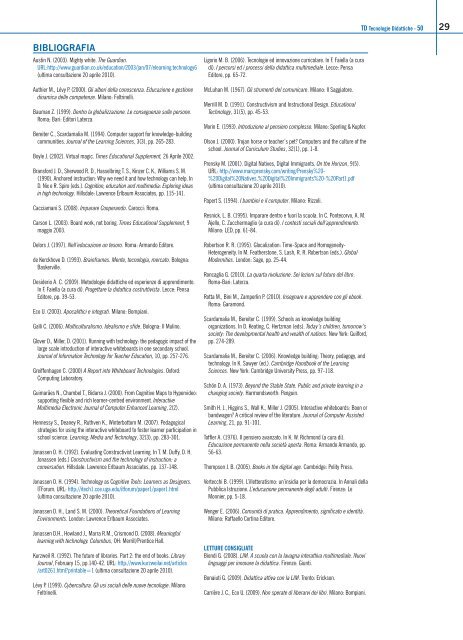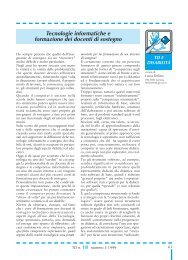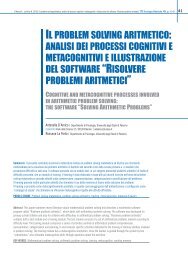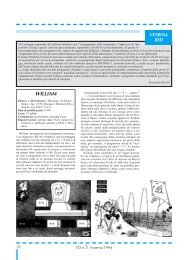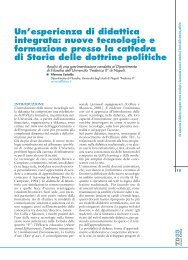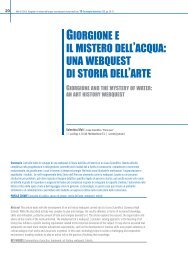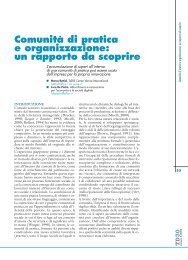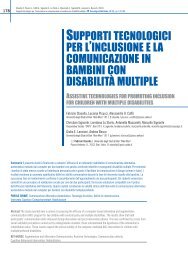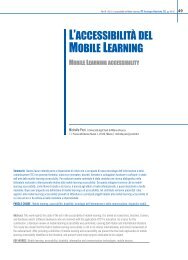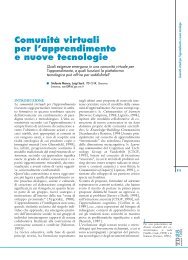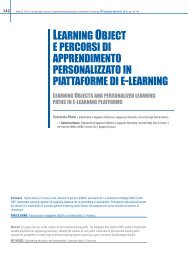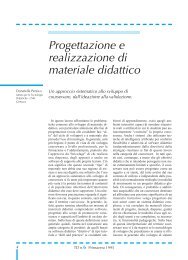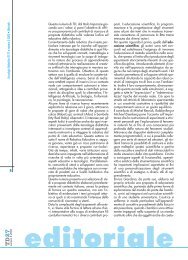apprendimento, tecnologia e scuola nella società della conoscenza
apprendimento, tecnologia e scuola nella società della conoscenza
apprendimento, tecnologia e scuola nella società della conoscenza
Create successful ePaper yourself
Turn your PDF publications into a flip-book with our unique Google optimized e-Paper software.
TD Tecnologie Didattiche - 50 29BIBLIOGRAFIAAustin N. (2003). Mighty white. The Guardian.URL:http://www.guardian.co.uk/education/2003/jan/07/elearning.technology6(ultima consultazione 20 aprile 2010).Authier M., Lévy P. (2000). Gli alberi <strong>della</strong> <strong>conoscenza</strong>. Educazione e gestionedinamica delle competenze. Milano: Feltrinelli.Bauman Z. (1999). Dentro la globalizzazione. Le conseguenze sulle persone.Roma; Bari: Editori Laterza.Bereiter C., Scardamalia M. (1994). Computer support for knowledge-buildingcommunities. Journal of the Learning Sciences, 3(3), pp. 265-283.Boyle J. (2002). Virtual magic. Times Educational Supplement, 26 Aprile 2002.Bransford J. D., Sherwood R. D., Hasselbring T. S., Kinzer C. K., Williams S. M.(1990). Anchored instruction: Why we need it and how technology can help. InD. Nix e R. Spiro (eds.). Cognition, education and multimedia: Exploring ideasin high technology. Hillsdale: Lawrence Erlbaum Associates, pp. 115-141.Cacciamani S. (2008). Imparare Cooperando. Carocci: Roma.Carson L. (2003). Board work, not boring. Times Educational Supplement, 9maggio 2003.Delors J. (1997). Nell’educazione un tesoro. Roma: Armando Editore.de Kerckhove D. (1993). Brainframes. Mente, <strong>tecnologia</strong>, mercato. Bologna:Baskerville.Desiderio A. C. (2009). Metodologie didattiche ed esperienze di <strong>apprendimento</strong>.In F. Faiella (a cura di). Progettare la didattica costruttivista. Lecce: PensaEditore, pp. 39-53.Eco U. (2003). Apocalittici e integrati. Milano: Bompiani.Galli C. (2006). Multiculturalismo. Idealismo e sfide. Bologna: Il Mulino.Glover D., Miller, D. (2001). Running with technology: the pedagogic impact of thelarge scale introduction of interactive whiteboards in one secondary school.Journal of Information Technology for Teacher Education, 10, pp. 257-276.Greiffenhagen C. (2000) A Report into Whiteboard Technologies. Oxford:Computing Laboratory.Guimarães N., Chambel T., Bidarra J. (2000). From Cognitive Maps to Hypervideo:supporting flexible and rich learner-centred environment. InteractiveMultimedia Electronic Journal of Computer Enhanced Learning, 2(2).Hennessy S., Deaney R., Ruthven K., Winterbottom M. (2007). Pedagogicalstrategies for using the interactive whiteboard to foster learner participation inschool science. Learning, Media and Technology, 32(3), pp. 283-301.Jonassen D. H. (1992). Evaluating Constructivist Learning. In T. M. Duffy, D. H.Jonassen (eds.) Constructivism and the technology of instruction: aconversation. Hillsdale: Lawrence Erlbaum Associates, pp. 137-148.Jonassen D. H. (1994). Technology as Cognitive Tools: Learners as Designers.ITForum. URL: http://itech1.coe.uga.edu/itforum/paper1/paper1.html(ultima consultazione 20 aprile 2010).Jonassen D. H., Land S. M. (2000). Theoretical Foundations of LearningEnvironments. London: Lawrence Erlbaum Associates.Jonassen D.H., Howland J., Marra R.M., Crismond D. (2008). Meaningfullearning with technology. Columbus, OH: Merrill/Prentice Hall.Kurzweil R. (1992). The future of libraries. Part 2: the end of books. LibraryJournal, February 15, pp.140-42. URL: http://www.kurzweilai.net/articles/art0261.html?printable=1 (ultima consultazione 20 aprile 2010).Lévy P. (1999). Cybercultura. Gli usi sociali delle nuove tecnologie. Milano:Feltrinelli.Ligorio M. B. (2006). Tecnologie ed innovazione curricolare. In F. Faiella (a curadi). I percorsi ed i processi <strong>della</strong> didattica multimediale. Lecce: PensaEditore, pp. 65-72.McLuhan M. (1967). Gli strumenti del comunicare. Milano: Il Saggiatore.Merrill M. D. (1991). Constructivism and Instructional Design. EducationalTechnology, 31(5), pp. 45-53.Morin E. (1993). Introduzione al pensiero complesso. Milano: Sperling & Kupfer.Olson J. (2000). Trojan horse or teacher’s pet? Computers and the culture of theschool. Journal of Curriculum Studies, 32(1), pp. 1-8.Prensky M. (2001). Digital Natives, Digital Immigrants. On the Horizon, 9(5).URL: http://www.marcprensky.com/writing/Prensky%20-%20Digital%20Natives,%20Digital%20Immigrants%20-%20Part1.pdf(ultima consultazione 20 aprile 2010).Papert S. (1994). I bambini e il computer. Milano: Rizzoli.Resnick, L. B. (1995). Imparare dentro e fuori la <strong>scuola</strong>. In C. Pontecorvo, A. M.Ajello, C. Zucchermaglio (a cura di). I contesti sociali dell’<strong>apprendimento</strong>.Milano: LED, pp. 61-84.Robertson R. R. (1995). Glocalization: Time-Space and Homogeneity-Heterogeneity. In M. Featherstone, S. Lash, R. R. Robertson (eds.). GlobalModernities. London: Sage, pp. 25-44.Roncaglia G. (2010). La quarta rivoluzione. Sei lezioni sul futuro del libro.Roma-Bari: Laterza.Rotta M., Bini M., Zamperlin P. (2010). Insegnare e apprendere con gli ebook.Roma: Garamond.Scardamalia M., Bereiter C. (1999). Schools as knowledge buildingorganizations. In D. Keating, C. Hertzman (eds). Today’s children, tomorrow’ssociety: The developmental health and wealth of nations. New York: Guilford,pp. 274-289.Scardamalia M., Bereiter C. (2006). Knowledge building: Theory, pedagogy, andtechnology. In K. Sawyer (ed.). Cambridge Handbook of the LearningSciences. New York: Cambridge University Press, pp. 97-118.Schön D. A. (1973). Beyond the Stable State. Public and private learning in achanging society. Harmondsworth: Penguin.Smith H. J., Higgins S., Wall K., Miller J. (2005). Interactive whiteboards: Boon orbandwagon? A critical review of the literature. Journal of Computer AssistedLearning, 21, pp. 91-101.Toffler A. (1976). Il pensiero avanzato. In K. W. Richmond (a cura di).Educazione permanente <strong>nella</strong> società aperta. Roma: Armando Armando, pp.56-63.Thompson J. B. (2005). Books in the digital age. Cambridge: Polity Press.Vertecchi B. (1999). L’illetteratismo: un’insidia per la democrazia. In Annali <strong>della</strong>Pubblica Istruzione. L’educazione permanente degli adulti. Firenze: LeMonnier, pp. 5-18.Wenger E. (2006). Comunità di pratica. Apprendimento, significato e identità.Milano: Raffaello Cortina Editore.LETTURE CONSIGLIATEBiondi G. (2008). LIM. A <strong>scuola</strong> con la lavagna interattiva multimediale. Nuovilinguaggi per innovare la didattica. Firenze: Giunti.Bonaiuti G. (2009). Didattica attiva con la LIM. Trento: Erickson.Carrière J. C., Eco U. (2009). Non sperate di liberarvi dei libri. Milano: Bompiani.


